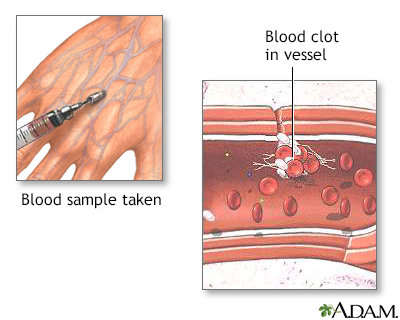Hemophilia
Hemophilia A; Classic hemophilia; Factor VIII deficiency; Hemophilia B; Christmas disease; Factor IX deficiency; Bleeding disorder - hemophilia
Hemophilia refers to a group of bleeding disorders in which blood clotting takes a longer time than normal.
There are two forms of hemophilia:
- Hemophilia A (classic hemophilia, or factor VIII deficiency)
- Hemophilia B (Christmas disease, or factor IX deficiency)
Images

I Would Like to Learn About:
Causes
When you bleed, a series of reactions take place in the body that helps blood clots form. This process is called the coagulation cascade. It involves special proteins called coagulation, or clotting factors. You may have a higher chance of excess bleeding if one or more of these factors are missing or aren't functioning like they should.
Hemophilia is caused by the lack of clotting factor VIII or IX in the blood. In most cases, hemophilia is passed down through families (inherited). Most of the time, it is passed to male children.
Symptoms
The main symptom of hemophilia is bleeding. Hemophilia can be mild, moderate, or severe. Mild cases may not be detected until later in life, after excessive bleeding following surgery or an injury. Precautions may need to be taken before engaging in sports.
In the worst cases, bleeding occurs for no reason. Internal bleeding may occur anywhere and bleeding into joints is common.
Exams and Tests
Most often, hemophilia is diagnosed after a person has an abnormal bleeding episode. It can also be diagnosed by a blood test done to detect the problem, if other family members have the condition.
Treatment
The most common treatment is to replace the missing clotting factor in the blood through a vein (intravenous infusions).
Special care during surgery needs to be taken if you have this bleeding disorder. So, be sure to tell your surgeon that you have this disorder.
It is also very important to share information about your disorder with blood relatives as they may also be affected.
Support Groups
Joining a support group where members share common issues can relieve the stress of a long-term (chronic) disease.
Outlook (Prognosis)
Most people with hemophilia are able to do normal activities. But some people have bleeding into the joints, which may limit their activity.
A small number of people with hemophilia may die of severe bleeding.
Related Information
Hemophilia AHemophilia B
Von Willebrand disease
References
Carcao M, Gomez K, Davide M, Pierce GF. Hemophilia A and B. In: Hoffman R, Benz EJ, Silberstein LE, et al, eds. Hematology: Basic Principles and Practice. 8th ed. Philadelphia, PA: Elsevier; 2023:chap 134.
Hall JE, Hall ME. Hemostasis and blood coagulation. In: Hall JE, Hall ME, eds. Guyton and Hall Textbook of Medical Physiology. 14th ed. Philadelphia, PA: Elsevier; 2021:chap 37.
Ragni MV. Hemorrhagic disorders: coagulation factor deficiencies. In: Goldman L, Schafer AI, eds. Goldman-Cecil Medicine. 26th ed. Philadelphia, PA: Elsevier; 2020:chap 165.
BACK TO TOPReview Date: 2/2/2023
Reviewed By: Mark Levin, MD, Hematologist and Oncologist, Monsey, NY. Review provided by VeriMed Healthcare Network. Also reviewed by David C. Dugdale, MD, Medical Director, Brenda Conaway, Editorial Director, and the A.D.A.M. Editorial team.

Health Content Provider
06/01/2025
|
A.D.A.M., Inc. is accredited by URAC, for Health Content Provider (www.urac.org). URAC's accreditation program is an independent audit to verify that A.D.A.M. follows rigorous standards of quality and accountability. A.D.A.M. is among the first to achieve this important distinction for online health information and services. Learn more about A.D.A.M.'s editorial policy, editorial process and privacy policy. A.D.A.M. is also a founding member of Hi-Ethics. This site complied with the HONcode standard for trustworthy health information from 1995 to 2022, after which HON (Health On the Net, a not-for-profit organization that promoted transparent and reliable health information online) was discontinued. |
The information provided herein should not be used during any medical emergency or for the diagnosis or treatment of any medical condition. A licensed medical professional should be consulted for diagnosis and treatment of any and all medical conditions. Links to other sites are provided for information only -- they do not constitute endorsements of those other sites. © 1997- 2025 A.D.A.M., a business unit of Ebix, Inc. Any duplication or distribution of the information contained herein is strictly prohibited.
